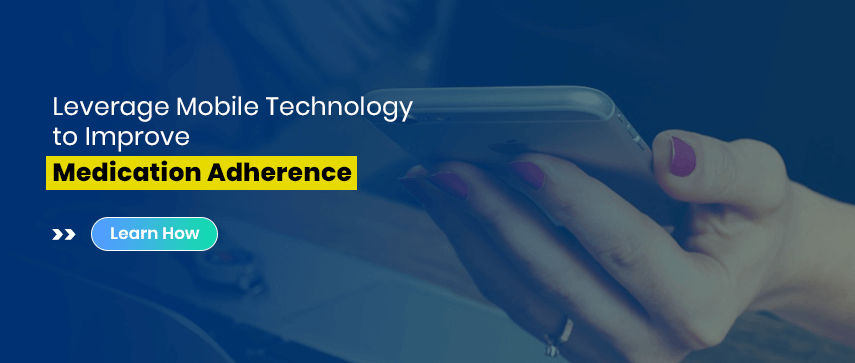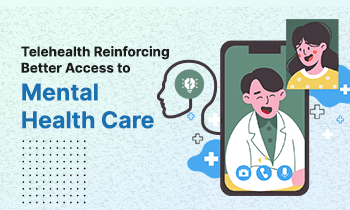“Drugs don’t work in patients who don’t take them.” – Former US Surgeon General C. Everett Koop
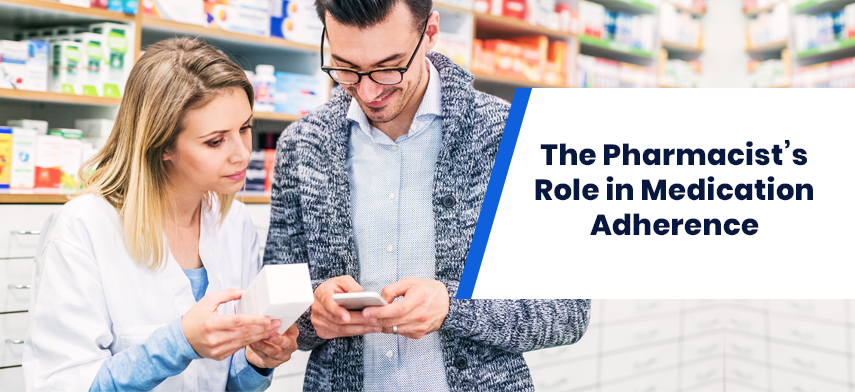
Non-compliance with prescribed regimens can cause grave health consequences. Worldwide, non-adherence is a major hurdle in providing effective healthcare, achieving disease control and preventing adverse events.
The World Health Organization defines medication adherence as “the degree to which a person’s behavior corresponds to the agreed recommendations from a healthcare provider.” Though medication adherence commonly refers to drug compliance, in a broader sense this includes all treatment instructions such as self-care, medical device use, exercises, and therapy sessions.

Missing even a single dose of treatment may trigger disease progression in cancer patients or cause a relapse for patients with multiple sclerosis. Though there are many smartphone-based technologies that remind patients about their medications or prescription refills, pharmacists still have a major role in increasing medication adherence. Adherence must be tackled as a team by the healthcare system, social networks as well as the caregivers. Though a single intervention or intervener cannot adequately address a problem as complicated as patient medication nonadherence, pharmacists can make a significant impact in many ways.
The Five Root Causes of Patient Non-Adherence to Medication
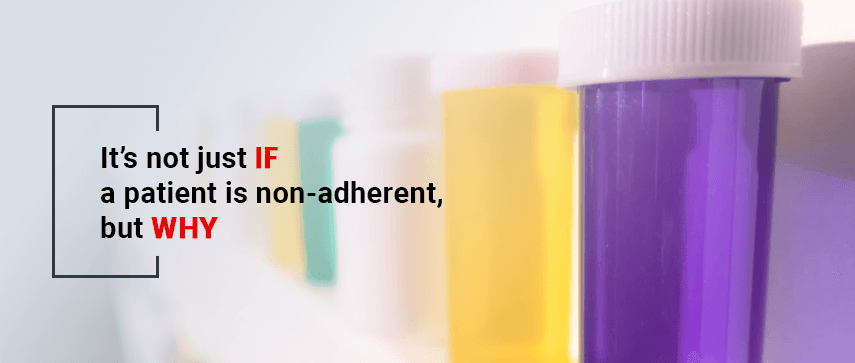
Patients have many reasons for not having taken their medications. While the reason may have been involuntary and as simple as having forgotten to take the medicine, there are many patients who voluntarily refuse the medications. The high cost of medicines, complex regimens of medications, lack of education or understanding about the medicines, wrong perceptions about the disease and the effectiveness of the drug involved are some of the reasons for not taking the medicines.
Some patients with asymptomatic diseases such as hypertension, diabetes, or hyperlipidemia may not feel the need to take medicines. Fear of adverse side effects, a general distrust of medications or poor patient-physician communication can lead to patients avoiding the given medications. Non-adherence to medication can lead to medical problems becoming more complicated and costlier in the long run. In order to improve the treatment outcomes and to reduce costs, health systems should study the major causes of non -adherence and figure out the best ways to overcome them.
- The high cost of medicines
 According to research, as medical costs go up, adherence goes down. It is understandable that patients will not take medicines if they cannot afford them in the first place. Healthcare providers must put in the effort to determine if a patient can afford the medicine being prescribed and help secure financial assistance for those who can’t.
According to research, as medical costs go up, adherence goes down. It is understandable that patients will not take medicines if they cannot afford them in the first place. Healthcare providers must put in the effort to determine if a patient can afford the medicine being prescribed and help secure financial assistance for those who can’t. - Lack of understanding about medicine regimen When patients do not understand how or when to take medicine, they may skip some doses or totally avoid the medication. Such patients will benefit from meetings with their pharmacists to learn properly about their medication regimens. The pharmacists can help them create pill calendars and teach them how to use apps that remind patients about the medications.
- Side effect scares

Most medicines have some side effects or the other. Some of these negative effects wear off when the patient adapts to the new treatment while certain side effects may be long-lasting. In such cases, the patient may require additional treatment to address these side effects. Non-adherence increases when patients don’t know who to turn to or what to do when they experience such unpleasant or scary side effects.
- Difficulty in refilling medication

Those suffering from chronic medical conditions will need to refill their medications on a regular basis. Non-adherence to medications occur when patients face difficulty in getting their prescriptions renewed. It can get quite frustrating when they have to make multiple calls to their physician’s office, wait on hold and navigate through complex phone trees only to be told to call again later. Centralized refill hotlines manned by pharmacists can solve such issues and ensure prescriptions are filled up without such hassles.
- Inconveniences in accessing medication

Non-adherence to medication occurs when patients find it inconvenient to get their medicines. We are all more likely to do things when they are easy to do so. Bedside delivery programs that ensure discharged patients have medication in hand while leaving the hospital improves the medicine adherence multifold. Mail order pharmacies for refills and co-locating retail pharmacies with outpatient clinics are a couple of other ways to solve such issues.
Role of the Pharmacist

A pharmacist is a person who dispenses medication. But the role of a pharmacist is actually much more complicated than that. Pharmacists can play a pivotal part in patient care through various means such as counseling, disease state management, medication therapy management and so on. They have a major role in improving patient’s medication adherence and therapeutic outcomes.
To be effective in their effort to ensure medication adherence, pharmacists must be diligent in involving the patient in the treatment experience. Pharmacists can also improve adherence by implementing a system that sends texts, emails or reminder calls regarding the medication regimen and refills.
Clinical Interventions are the professional actions from registered pharmacists that are aimed at improving the quality of medicine use. These include recommendations for changes in the patient’s medication therapy, the means of medication administration or the medication-taking behavior.
Medication Therapy Management (MTM)
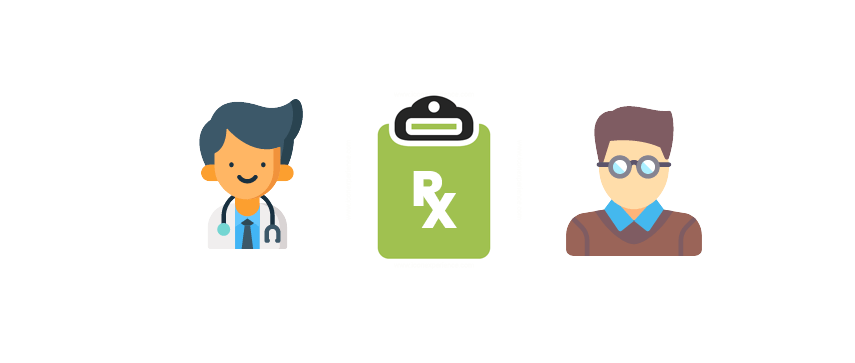
According to a report on health literacy from the Institute of Medicine, millions of people have difficulty in understanding and using health information. This issue worsens when many patients hide their doubts from their physicians as they feel too embarrassed or intimidated to ask for help.
Medication Therapy Management (MTM) is a consumer-friendly program designed by pharmacists to find and resolve the more at-risk patients. MTM is a healthcare service wherein the medicines are delivered in a face-to-face visit between the pharmacist and the patient. MTM is more useful for patients who consume multiple (eight plus) separate drugs.
As per the latest health care reform laws such as the Patient Protection and Affordable Care Act, pharmacists will be paid for providing MTM services for patients. Under the patient-centered medical home healthcare model, pharmacists can be part of a physician/nurse practitioner-led healthcare teams. MTM consultation fees are reimbursable provided it meets certain guidelines set by the Centers for Medicare & Medicaid Services. Medication Therapy Management is a healthcare service with high potential as it improves patient adherence while providing a supplemental revenue stream for pharmacists.
5 Pharmacist Interventions That Improve Medication Adherence

Each and every patient is unique and different factors influence a patient’s medication adherence. Pharmacists should communicate effectively with individual patients to determine their adherence levels and understand the hurdles they face in taking their medication correctly. The patient must be made to understand the benefits of adherence as well as the consequences of nonadherence.
- Recommend patients stick to one pharmacy: When patients fill their prescriptions from different pharmacies over a period of time, it becomes difficult for pharmacists to track the patient’s medications and treatments. The risk of the drug to drug interactions increase with each added prescription. Sticking with just one pharmacy ensures that all patient prescriptions are reviewed by the same pharmacist. This helps them better track patients, reduce the chances of adverse events and provide informed therapeutic recommendations.
- Asking the right questions: The University of Missouri conducted a study on adherence approaches. The study which involved 6665 heart failure patients concluded that healthcare providers should focus on patient behavior, rather than patient education about their medications. To determine a patient’s level of adherence, pharmacists should ask the right questions:“How do you remember to take your medications?”
“How would you know if you missed a dose?”
“How do you organize your medications?”
The answers to such questions can help pharmacists find customized solutions to specific non-adherence issues. This also creates a shift in the patient’s perspective that a pharmacist is more than just a source of medication information, but also a resource for solving adherence-related issues.
- Recommend patients to maintain medication lists: Pharmacists should encourage patients to maintain lists of medications they take. Such lists should contain all information regarding their medication regimen including names of drugs, the medical condition it is for, the dosages and the timings. Pharmacists should also advise their patients to give copies of these lists to loved ones in case of emergencies. Keeping a copy for the physician during checkups help them be aware of side effects/interactions that may occur.
- Recommend usage of dosing cards, pill dispensers, and medication apps: Creating a dosing card with essential information regarding a patient’s medication, such as the pill’s name, the treatment it is for, dosage timings and an image if possible, can be very helpful for patients taking multiple medicines. This can be especially useful for patients with cognitive barriers. Medication reminder apps are another great tool that improves adherence. Pharmacists can recommend which mobile apps are suitable for their patients. Reminders set on pharmacy apps usually pop up like push notifications when it’s time to take each medicine. Reminders can be set for different medications – multiple times a day, different days of the week, the different dosages or number of pills per dose – as required by the patient. Pharmacists can recommend the use of pillboxes to patients as a great way to organize their medicines. They can even stock up on various models of pillboxes at their pharmacy and help patients choose a suitable pill box based on the given prescription. A standard pill box has a separate compartment for each day of the week. The visual element of such an arrangement helps alert the patient if they missed a dose.
- Simplify patients’ medications: Pharmacists can review prescriptions, while filling it, to confirm that the dosing schedule is as simple as possible. They can communicate with the patients about adverse side effects they experience and the consult with the physician to suggest suitable alternatives. Minimizing adverse effects and dosing simplification are exceedingly successful strategies that boost up medicine adherence.
The National Community Pharmacists Association (NCPA) launched an initiative known as ‘Simplify My Meds’ to improve adherence. This enabled pharmacists to combine and organize patients’ medications such that all their medications can be collected on the same day of every month. This initiative resulted in a 30% increase in prescriptions and revenue of the pharmacies that implemented it while the patients appreciated the customized service and the convenience it provided.
Wrapping Up!!
Achieving proper medication adherence can be a difficult task for patients, especially those undergoing multiple treatments with drastically different medicine timings and doses. For effective outcomes in terms of recovery as well as the cost of treatments, It is important that medications are being taken according to the doctor’s instructions.
Pharmacists have a major role in improving medication adherence in patients. They can confirm that patients are on the correct medications and are not taking any other treatments/drugs that may undermine the effectiveness of important therapies. Medication Therapy Management can help pharmacists identify at-risk patients and help them resolve their medication adherence issues. They can educate patients about suitable pharmacy apps to set medication reminders on their phones. There are several other clinical interventions that pharmacists can execute to encourage their patients to take the right dosages on schedule, get refills on time and to deal with side effects of medicines.
Author's Bio

Shailendra Sinhasane (Shail) is the co-founder and CEO of Mobisoft Infotech. He has been focused on cloud solutions, mobile strategy, cross-platform development, IoT innovations and advising healthcare startups in building scalable products.
 According to research, as medical costs go up, adherence goes down. It is understandable that patients will not take medicines if they cannot afford them in the first place. Healthcare providers must put in the effort to determine if a patient can afford the medicine being prescribed and help secure financial assistance for those who can’t.
According to research, as medical costs go up, adherence goes down. It is understandable that patients will not take medicines if they cannot afford them in the first place. Healthcare providers must put in the effort to determine if a patient can afford the medicine being prescribed and help secure financial assistance for those who can’t.




